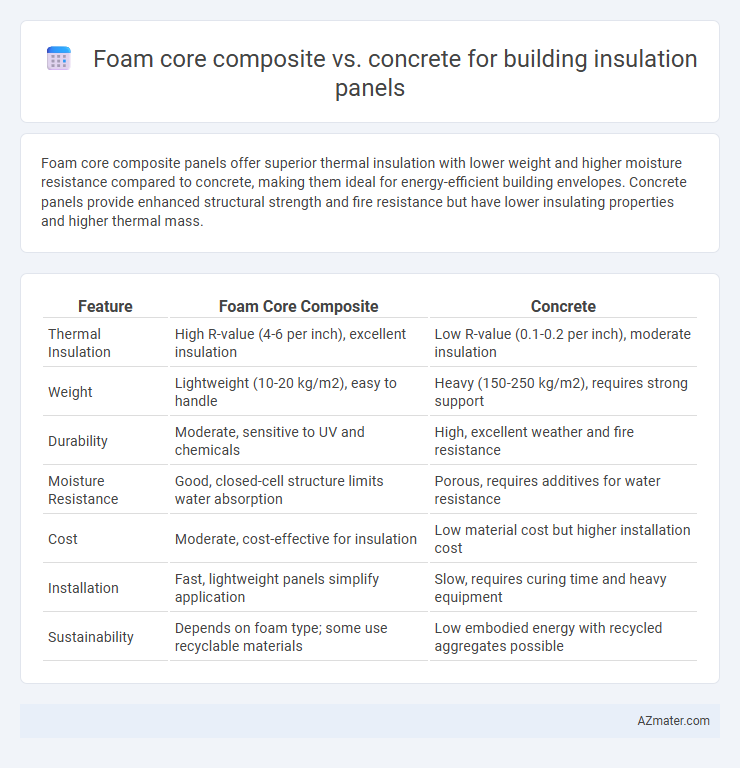Foam core composite panels offer superior thermal insulation with lower weight and higher moisture resistance compared to concrete, making them ideal for energy-efficient building envelopes. Concrete panels provide enhanced structural strength and fire resistance but have lower insulating properties and higher thermal mass.
Table of Comparison
| Feature | Foam Core Composite | Concrete |
|---|---|---|
| Thermal Insulation | High R-value (4-6 per inch), excellent insulation | Low R-value (0.1-0.2 per inch), moderate insulation |
| Weight | Lightweight (10-20 kg/m2), easy to handle | Heavy (150-250 kg/m2), requires strong support |
| Durability | Moderate, sensitive to UV and chemicals | High, excellent weather and fire resistance |
| Moisture Resistance | Good, closed-cell structure limits water absorption | Porous, requires additives for water resistance |
| Cost | Moderate, cost-effective for insulation | Low material cost but higher installation cost |
| Installation | Fast, lightweight panels simplify application | Slow, requires curing time and heavy equipment |
| Sustainability | Depends on foam type; some use recyclable materials | Low embodied energy with recycled aggregates possible |
Introduction to Building Insulation Panels
Building insulation panels significantly improve energy efficiency by reducing heat transfer through walls and roofs. Foam core composites offer lightweight, high thermal resistance with superior moisture resistance compared to traditional concrete panels. Concrete insulation panels provide durability and fire resistance but generally exhibit lower R-values and heavier weight, impacting installation and overall building performance.
Overview of Foam Core Composite Panels
Foam core composite panels consist of a rigid foam insulation core bonded between two durable facings, offering excellent thermal resistance and lightweight strength ideal for building insulation. These panels provide superior thermal performance with low thermal conductivity values, typically ranging between 0.020 to 0.030 W/m*K, significantly reducing heat transfer compared to conventional concrete. Foam core composites also offer enhanced moisture resistance, faster installation times, and improved sustainability due to reduced material usage and recyclability.
Concrete Panels in Modern Construction
Concrete panels in modern construction offer superior thermal mass, enhancing energy efficiency by stabilizing indoor temperatures and reducing heating and cooling demands. These panels provide excellent fire resistance and durability, outperforming foam core composites by maintaining structural integrity under extreme conditions. Advanced concrete formulations enable lightweight, high-insulation panels that comply with stringent building codes while supporting sustainable design goals.
Thermal Performance Comparison
Foam core composite panels provide superior thermal insulation compared to traditional concrete panels, offering lower thermal conductivity values typically ranging between 0.02 to 0.04 W/m*K, whereas concrete panels often exhibit thermal conductivity around 1.4 W/m*K. This significant difference results in enhanced energy efficiency and reduced heat transfer in buildings utilizing foam core composites, contributing to lower heating and cooling costs. Additionally, foam core panels maintain consistent thermal resistance under varying environmental conditions, making them an optimal choice for insulation in energy-efficient building designs.
Structural Strength and Durability
Foam core composite panels provide high structural strength due to their lightweight yet rigid core materials combined with durable outer facings, making them resistant to deformation and impact. Concrete insulation panels offer exceptional durability and load-bearing capacity, excelling in fire resistance and longevity under extreme weather conditions. While foam core composites deliver better thermal insulation efficiency with adequate strength for most building applications, concrete panels are preferred when superior structural robustness and long-term durability are critical.
Moisture Resistance and Weathering
Foam core composite panels offer superior moisture resistance compared to concrete, as their closed-cell structure prevents water absorption and reduces the risk of mold and mildew growth. Concrete insulation panels can suffer from water penetration and freeze-thaw cycles, leading to cracking and reduced thermal performance over time. Due to its inherent resiliency, foam core composites maintain insulation integrity and weathering durability in harsh climates, making them a more reliable choice for long-term building envelope protection.
Fire Resistance and Safety Aspects
Foam core composite insulation panels offer superior fire resistance compared to traditional concrete panels due to their engineered fire-retardant additives and non-combustible outer layers. Concrete panels naturally possess high fire resistance stemming from their inorganic composition, providing excellent thermal mass that delays heat transfer during a fire event. For optimal building safety, foam core composites must meet stringent fire codes and certifications, while concrete panels inherently achieve high fire safety ratings without additional treatments.
Environmental Impact and Sustainability
Foam core composite insulation panels typically have lower embodied carbon compared to traditional concrete panels, as they require less energy-intensive manufacturing processes and often incorporate recycled materials. Concrete panels, while durable and offering thermal mass benefits, contribute significantly to CO2 emissions during cement production and have a larger environmental footprint over their lifecycle. Sustainable building practices favor foam core composites for insulation due to their recyclability, reduced waste generation, and potential for improved energy efficiency in structures.
Installation Process and Cost Efficiency
Foam core composite panels offer a quicker installation process due to their lightweight nature and ease of cutting, significantly reducing labor time compared to concrete insulation panels which require heavier handling and curing periods. Cost efficiency favors foam core composites as they lower overall expenses through decreased labor costs and minimal need for specialized equipment, while concrete panels involve higher material and installation costs due to their density and strength requirements. Foam core composites also provide improved thermal insulation, further enhancing cost savings on energy bills over the building's lifespan.
Choosing the Right Panel: Key Considerations
Foam core composite panels offer superior thermal insulation with higher R-values per inch compared to traditional concrete panels, making them ideal for energy-efficient building designs. Concrete panels provide excellent durability and fire resistance but are heavier and less effective in preventing heat transfer, requiring thicker profiles for comparable insulation. Selecting the right panel depends on balancing insulation performance, structural requirements, fire safety standards, and budget constraints to achieve optimal building efficiency.

Infographic: Foam core composite vs Concrete for Building insulation panel
 azmater.com
azmater.com